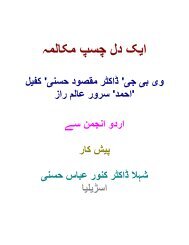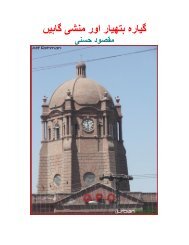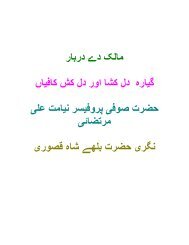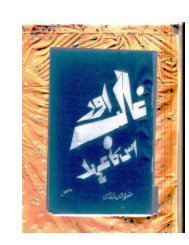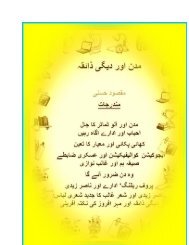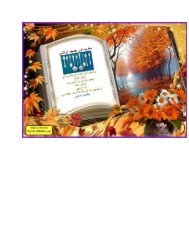Tarikhi Rovaet ka FAISLA
Tarikhi Rovaet ka FAISLA jo daikh rahe hain yahhi hai, yahhi rahe ga. issay bai'bas, bai'kas la'char tanha aur yateem bananay walay sachay suchay aur ouchay hain. Tarikh main wohhi insaniat ke khidmat'gar tehra'ay jatay rahain ge. ji haan wohhi Maqsood Hasni
Tarikhi Rovaet ka
FAISLA
jo daikh rahe hain yahhi hai, yahhi rahe ga.
issay bai'bas, bai'kas la'char tanha aur yateem bananay walay sachay suchay aur ouchay hain.
Tarikh main wohhi insaniat ke khidmat'gar tehra'ay jatay rahain ge.
ji haan wohhi
Maqsood Hasni
You also want an ePaper? Increase the reach of your titles
YUMPU automatically turns print PDFs into web optimized ePapers that Google loves.
<strong>Tarikhi</strong> <strong>Rovaet</strong> <strong>ka</strong><br />
<strong>FAISLA</strong><br />
jo daikh rahe hain yahhi hai, yahhi<br />
rahe ga.<br />
issay bai'bas, bai'<strong>ka</strong>s la'char<br />
tanha aur yateem bananay walay<br />
sachay suchay aur ouchay hain.<br />
Tarikh main wohhi insaniat ke<br />
khidmat'gar tehra'ay jatay rahain<br />
ge.<br />
ji haan wohhi<br />
Maqsood Hasni
<strong>Tarikhi</strong> <strong>Rovaet</strong> <strong>ka</strong><br />
<strong>FAISLA</strong><br />
Fatay <strong>ka</strong>isa bhi raha ho,<br />
ossay hamaisha sacha sucha aur haq<br />
par mana giya hai.<br />
Maftu <strong>ka</strong>zour moflis bai’bas<br />
bai'<strong>ka</strong>s, majboor<br />
haq aur rasti par ho hi nahain<br />
sakta<br />
Waqt aur log taqat <strong>ka</strong> sath daitay<br />
hain<br />
yah'hi tarekh <strong>ka</strong> atal faisla raha<br />
hai<br />
yahhi <strong>ka</strong>ghaz par marqoum lafzoun
ki<br />
haqiqat aur oon <strong>ka</strong> pas-e-manzar<br />
hai.<br />
Mahmood Ghaznavi <strong>ka</strong>y 16 hamloun<br />
<strong>ka</strong>y<br />
mota’alaq tarikh khamosh hai<br />
laikin 17vain hamlay say her koee<br />
waqif hai.<br />
Is almiay ki kiya vaja hai?!<br />
Admi nay hamaisha<br />
paiat say socha hai<br />
laikin jo damagh say sochtay hain<br />
donya oon <strong>ka</strong>y liay su<strong>ka</strong>r jati hai.<br />
Apnay para’ay eak hi saaf main<br />
kharay ho jatay hain.<br />
Is tasveer <strong>ka</strong> sha<strong>ka</strong>s aaj matoub hai<br />
laikin fata ki surat main yah puri<br />
almi baradri <strong>ka</strong> hero aur<br />
nijaat'dahinda ke laqb se malqoob<br />
hota.
Fata ki surat main bila'shuba yah<br />
bhi wohhi kuch <strong>ka</strong>rta jo dosray<br />
<strong>ka</strong>rtay aa'ay hain.<br />
Lashain bich jatein.<br />
Chappay chappay par suli ghat<br />
bantay.<br />
Falain tabah ho jatein.<br />
Waghera waghera<br />
Haan.
Haar <strong>ka</strong>r bohat souoon ko charchali<br />
garift se aazad <strong>ka</strong>ra gya.<br />
Kya is sha<strong>ka</strong>s ne <strong>ka</strong>bhi bhi bar e<br />
sagher par hamla kiya.<br />
Nahain<br />
kya bar e sagher ki fojain is ke<br />
khalaf nahain larti rahain,<br />
agarchah woh bartanvi fojain<br />
thein.<br />
Lariein<br />
kya kharaj dainay se in<strong>ka</strong>r par<br />
bartaniya jo taqat ke nasha main<br />
sar'shar tha, ne shar ko agay<br />
nahain barhaya.<br />
barhaya<br />
Yah darust hai <strong>ka</strong>h ishtial ke jawab<br />
main is shakhas ke hawala se<br />
lakhoon log maray ge<br />
Dosri taraf charchal fatohi <strong>ka</strong>mal<br />
se <strong>ka</strong>roroon log maray ya motasar<br />
nahain howay.
yah shakhas insaniat <strong>ka</strong> dushmun<br />
samjha jata hai jab'<strong>ka</strong>h morakh ne<br />
charchal ko insaniat <strong>ka</strong> mama bana<br />
<strong>ka</strong>r rakh diya hai.<br />
Japan ke dou shehar aitam bumb <strong>ka</strong><br />
nishana banay.<br />
Kya on shehroon main basnay walay<br />
bachay bohray ourtain baghi thein.<br />
Kya jarnal tajo 2 din pehlay<br />
haityar nahain daal chu<strong>ka</strong> tha.<br />
kya yah dou tara ke alag se bumb<br />
nahain thay.<br />
Kya issay islay ke tajarbay <strong>ka</strong> naam<br />
nahain diya ja sakta.<br />
Fojain fojoon ko marnay ke liay<br />
hoti hain. Eak dosray ko marain.<br />
Shah ki gomashtgi ke bagher oon ki<br />
ban nahain aati laikin logoon ko<br />
<strong>ka</strong>yoon maray.<br />
logoon <strong>ka</strong> shahoon ki baad'mashioon
se kya laina daina hota hai. Woh<br />
gareeb to laraee ki vajo aur<br />
moamlaat ko bhi nahain jantay<br />
hotay.<br />
Sawal yah hai <strong>ka</strong>h log kya <strong>ka</strong>rain<br />
woh to bai'bas hotay hain. shah to<br />
hotay hi onhain barbad <strong>ka</strong>rnay ke<br />
liay.<br />
Baishak log kuch nain <strong>ka</strong>r saktay,<br />
haan<br />
In se nafrat to <strong>ka</strong>r saktay hain<br />
In par lanat to bhaij saktay hain.<br />
In se Allah ki panah to mang saktay<br />
hain<br />
In ke her <strong>ka</strong>hay ko jhoot aur faraib<br />
to samjh saktay hain<br />
Monh par nasahi dil main to yah sab<br />
<strong>ka</strong>r saktay hain.
Hiroshima<br />
Hiroshima, Japanese city,<br />
situated some 8M km. (500 mi.) from<br />
Tokyo, on which the first<br />
operational atomic bomb was
dropped at 0815 on 6 August 1945.<br />
Nicknamed 'Little Boy’—a<br />
reference to Roosevelt—the bomb<br />
was 3 m. (9 ft. 9 in.) long, used<br />
uranium 235, had the power of 12.5<br />
kilotons of TNT, and weighed 3,600<br />
kg. (nearly 8,000 lb.).<br />
Much discussion by a Target<br />
committee had preceded the<br />
decision to make Hiroshima the<br />
first target. To be able to assess<br />
the damage it caused, and to<br />
impress the Japanese government<br />
with the destruction it was<br />
expected to wreak, it was<br />
necessary to choose a city that had<br />
not yet been touched by the USAAF’s<br />
strategic air offensives. Kyoto<br />
was also considered but its<br />
unrivalled beauty ruled it out.<br />
The bomb was delivered by a US B29<br />
bomber, nicknamed Enola Gay, from<br />
the Pacific island of Tinian.<br />
Dropped by parachute it exploded<br />
about 580 m. (1,885 ft.) above the
ground, and at the point of<br />
detonation the temperature<br />
probably reached several million<br />
degrees centigrade. Almost<br />
immediately a fireball was created<br />
from which were emitted radiation<br />
and heat rays, and severe shock<br />
waves were created by the blast. A<br />
one-ton (900 kg.) conventional<br />
bomb would have destroyed all<br />
wooden structures within a radius<br />
of 40 m. (130 ft.). Little Boy<br />
destroyed them all within a radius<br />
of 2 km. (1.2 mi.) of the<br />
hypocentre (the point above which<br />
it exploded). The terrain was flat<br />
and congested with administrative<br />
and commercial buildings, and the<br />
radius of destruction for the many<br />
reinforced concrete structures<br />
was about 500 m. (1,625 ft.),<br />
though only the top stories of<br />
earthquake-resistant buildings<br />
were damage or destroyed.<br />
Altogether an area of 13 sq. Ikm.<br />
(5 sq. mi.) was reduced to ashes<br />
and of the 76,000 buildings in the
city 62.9% were destroyed and only<br />
8% escaped damage.<br />
Within 1.2 km. (.74 mi.) of the<br />
hypocentre there was probably a<br />
50% death rate of the 350,000<br />
people estimated to have been in<br />
Hiroshima at the time. Hiroshima<br />
City Survey Section estimated a<br />
figure of 118,661 civilian deaths<br />
up to 10 August 1946 (see Table).<br />
Add to this a probable figure of<br />
20,000 deaths of military<br />
personnel and the current<br />
figure—for people are still dying<br />
as a result of the radiation<br />
received—is in the region of<br />
140,000. Among those who survived,<br />
the long-term effects of radiation<br />
sickness, genetic and chromosome<br />
injury, and mental trauma have<br />
been catastrophic, even unborn<br />
children having been stunted in<br />
growth and sometimes mentally<br />
retarded.<br />
Committee on Damage by Atomic
Bombs in Hiroshima and Nagasaki,<br />
Hiroshima and Nagasaki: The<br />
Physical, Medical, and Social<br />
Effects of the Atomic Bombings<br />
(London, 1981).<br />
Nagasaki<br />
Nagasaki, Japanese city on which
the second operational atomic bomb<br />
was dropped. Nicknamed 'Fat Man'<br />
(a reference to Churchill), the<br />
bomb, which used plutonium 239,<br />
was dropped by parachute at 1102 on<br />
9 August by an American B29 bomber<br />
from the Pacific island of Tinian.<br />
It measured just under 3.5 m. (11<br />
ft. 4 in.) in length, had the power<br />
of 22 kilotons of TNT, and weighed<br />
4,050 kg. (nearly 9,000 lb.). The<br />
aircraft's first target was the<br />
city of Kokura, now part of<br />
Kitakyushu, but as it was covered<br />
by heavy cloud the aircraft was<br />
diverted to its second target,<br />
Nagasaki.<br />
Unlike Hiroshima, Nagasaki lies in<br />
a series of narrow valleys<br />
bordered by mountains in the east<br />
and west. The bomb exploded about<br />
500 m. (1,625 ft.) above the ground<br />
and directly beneath it (the<br />
hypocentre) was a suburb of<br />
schools, factories, and private<br />
houses. The radius of destruction
for reinforced concrete buildings<br />
was 750 m. (2,437 ft.), greater<br />
than at Hiroshima where the blast<br />
caused by the bomb was more<br />
vertical. But because of the<br />
topography, and despite the<br />
Nagasaki bomb being more powerful,<br />
only about 6.7 sq. km. (2.6 sq.<br />
mi.) of Nagasaki was reduced to<br />
ashes compared with 13 sq. km. (5<br />
sq. mi.) of Hiroshima. Of the<br />
51,000 buildings in the city 22.7%<br />
were completely destroyed or burt,<br />
with 36.1 % escaping any damage.<br />
Among the 270,000 people present<br />
when the bomb was dropped, about<br />
2,500 were labour conscripts from<br />
Korea and 350 were<br />
prisoners-of-war. About 73,884<br />
were killed and 74,909 injured,<br />
with the affected survivors<br />
suffering the same long-term<br />
catastrophic results of radiation<br />
and mental trauma as at Hiroshima.<br />
Committee on Damage by Atomic
Bombs in Hiroshima and Nagasaki,<br />
Hiroshima and Nagasaki: The<br />
Physical, Medical and Social<br />
Effects of the Atomic Bombings<br />
(London, 1981).<br />
http://www.english.illinois.edu/maps/poets/g_l/l<br />
evine/bombing.htm



